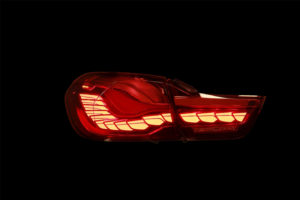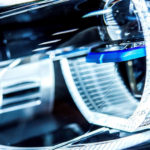Automotive lighting solutions and technologies have developed rapidly in the last 10 years, but there’s still more to come, says Osram. PMM finds out more about the company’s collaboration with VMs and OEMs, which is producing the next generation of lighting technologies.
OLED TECHNOLOGY
OLEDs contain organic materials. They are enclosed by flat electrodes, which serve as the electrical contacts. When power is supplied, photons are produced in the layers, causing the diode to emit light. Since OLEDs produce light in thin layers, they are well- suited to flexible lighting solutions. The possibility of controlling individual light modules separately opens up more design options, such as dynamic functionality. In addition to offering enormous flexibility of design, OLED technology consumes very little energy, which is of great benefit in the automotive industry, says Osram.
This technology is now in the tail lights of the new BMW M4 GTS production vehicle. CEO of Specialty Lighting at Osram, Hans- Joachim Schwabe, claims, “Our OLEDs in the tail lights of the BMW M4 GTS make us the first company to have this technology on the road in a production vehicle. Yet again, we are demonstrating our pioneering role in the automotive sector.” With 15 OLEDs per tail light, and a brightness of 1.200 cd/m2, the tail lights in the BMW M4 GTS provide great visibility on the road and perform all the rear light functions.
MATRIX (PIXEL) LIGHTING
A German research alliance between members from both industry and research, has developed a headlight model containing three LED light sources, each with 1,024 individually controllable light points (pixels). This allows the headlight to adapt to different traffic situations, ensuring optimum light conditions without dazzling other drivers. In addition, with the aid of sensors in the vehicle, the surroundings can be analysed in order to illuminate oncoming traffic.
In the current generation of adaptive headlights on the market today, several LED components are installed in the headlights, side by side and on top of each other.
Additional electronic components are required to switch light segments on and off. The number of segments is limited due to the restricted space in the headlight. In this new approach, electronic activation of the LED is integrated within the chip, resulting in a much higher resolution, while still meeting limited space requirements. In a second step for this automotive lighting, the Osram Specialty Lighting division developed an LED module. It features an electrical and thermal interface that enables direct connection to the vehicle’s electronics.
LASER TECHNOLOGY
Laser technology works in combination with other driver assistance functions and throws light up to 600m on the road ahead, providing better visibility for drivers at night. Osram has worked together with BMW to develop light source and headlight technology for a laser high beam which is already in use on the BMW i8 and BMW 7 series cars. Additionally, Osram and BMW have implemented an integrated fail-safe system that prevents blue laser light (used in the Laser light technology) from being emitted in the event of a malfunction, crash or manipulation.
Osram has already developed further generations of laser technology which will soon be installed in other vehicle makes and models, and BMW is planning to install laser light in a number of series cars, which will be updated in the next few years.











